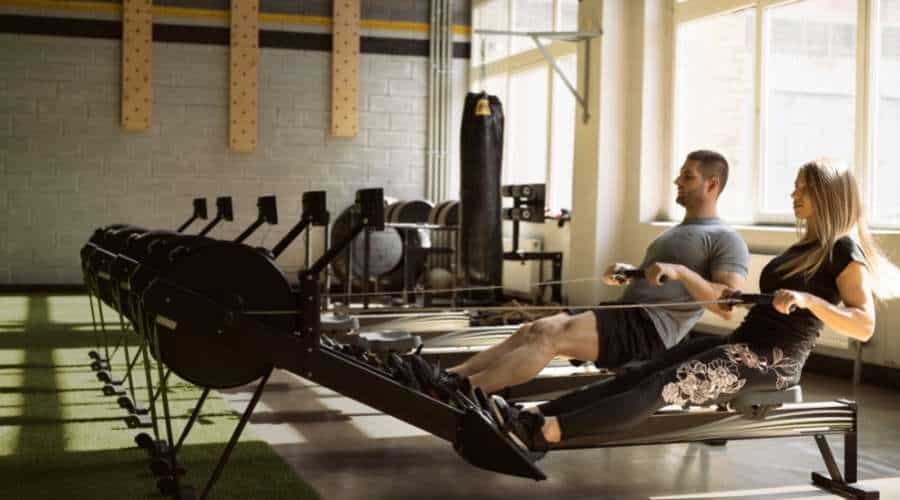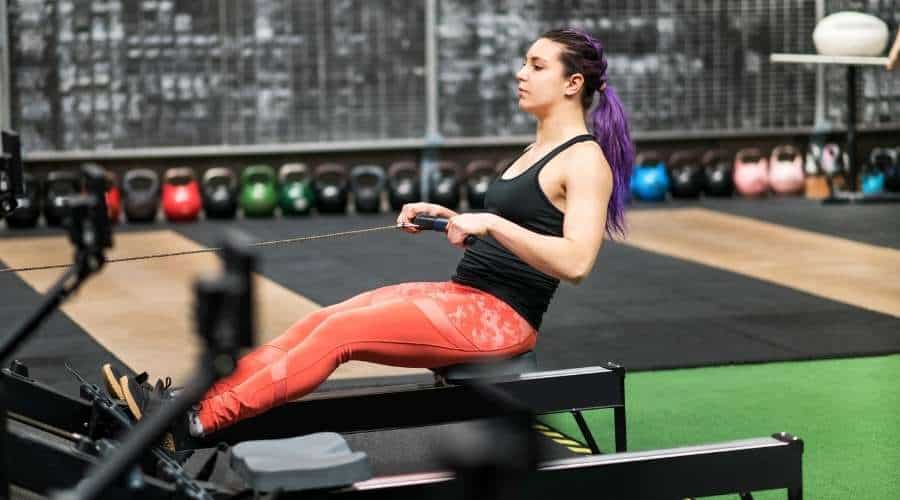Rowing on a machine makes for the ideal workout because it exercises the entire body while building power and endurance. Your options for putting it in a WOD include:
- Setting a numeric goal, such as 250 meters for a warm-up or 2,000 meters for time,
- Specifying a time limit, such as five minutes at any effort for beginners.
- Mixing it with other Crossfit movements, such as two rounds of a 500-meter row followed by 30 snatches.
In this post, we’ll take a look at some of our favorite rowing WODs, along with advice on rowing technique and workout alternatives to try if you don’t have access to an erg machine.
First, Why Row?
As part of your WOD, rowing offers many advantages.
- It is a full-body workout that focuses on the glutes, quadriceps, hamstrings, and calves, but also takes care of the arms, shoulders, pecs, abs, and obliques.
- The exercise builds endurance by strengthening the heart and lungs.
- You can increase the intensity of the exercise by pulling harder on the handle, which builds power.
- Rowing burns calories. According to Harvard Health Publishing, moderate rowing burns 420 calories per hour for a 125-lb. Person, 504 calories for a 155-lb. Person, and 588 calories for a 185-lb. person.
- Because you row from a seated position, this low-impact exercise is easier on the joints, especially the back and knees, and minimizes the risk of injury to those areas.
- Unlike the more complex movements of double-unders or the snatch, rowing is easy to learn and simple to do. Crossfitters at all fitness and skill levels can do it.
9 Rowing WOD Ideas to Try
Rowing is versatile enough to be used as a warm-up, a complete WOD by itself, or as part of a more complex workout with other movements. The following are a few examples.
Warm-Ups
Because rowing moves the entire body, you can do any of the following warm-ups even if the upcoming WOD has nothing to do with rowing.
- Row for a specified amount of time, such as two or five minutes. Beginners can do this at a low intensity while more experienced Crossfitters can row harder.
- Row for a specified number of meters, such as 250, or a specified number of calories, such as 50.
- Try a three-song rowing playlist. Row at an easy pace for the first song, a medium pace for the second, and a hard pace for the third.
You can also mix rowing with other movements for a warm-up, such as in the following example, which you can do in sequence.
- Two minutes on a rowing machine.
- Two minutes on an exercise bike.
- Two minutes on a SkiErg
- Two rounds of 10 pullups, 10 pushups, and 10 situps.
Rowing-Only WODs
WODs that only include rowing are limited only by your imagination.
- Row the maximum calories or meters for time, such as for 15, 30, or 60 minutes. WOD #4 for the first day of 2018 Crossfit Games was a marathon row of 42,195 meters with a time cap of four hours.
- Do four rounds of 30 seconds of rowing plus 30 seconds of rest. Score the total number of meters. If you want more of a challenge, do 10 rounds of one minute of rowing followed by a minute of rest.
- Two rounds for time: 500-meter row plus two minutes of rest. You can repeat this WOD every few weeks to gauge your progress.
Jerry
The first of the rowing combos is a Hero WOD called “Jerry” in memory of Sgt. Major Jerry Dwayne Patton, 40, who died on October 15, 2008 during High Altitude High Opening training while preparing for a deployment to Afghanistan.
For time, do the following in sequence.
- One-mile run
- 2,000-meter row
- One-mile run
Beginners can scale to 800 meters for the run and 1,000 meters for the row.
Helen with Rowing
This WOD swaps out running for rowing in the Helen, one of the Crossfit workouts named for females.
For time, do three rounds of.
- 400-meter row.
- 21 kettlebell swings at 53 lbs. for men or 35 lbs. for women.
- 12 pullups.
Row with Squat Cleans EMOM
EMOM (Every Minute On the Minutes) for 12 minutes, alternate between the following two exercises:
- 20-calorie row. Do this on minutes 0, 2, 4, 6, etc.
- 3 heavy squat cleans. Add more weight with each set. Do this on minutes 1, 3, 5, 7, etc.
Rowing and Running
For time, do the following:
- 2000-meter row
- 1,500-meter run
- 2,000-meter row
Row and Thruster
Do the following for time in a descending ladder of 27-21-15-9:
- Row for the specified calories
- Do thrusters for the specified number of reps. Use 95 lbs. for men and 65 lbs. for women.
Laura
Another hero WOD, Laura, was named for Special Agent Laura Schwartzenberger, 43, who was shot on Feb. 2, 2021, while executing a search warrant on a suspected child pornographer in Florida.
With a partner, do the following 21-minute AMRAP (As Many Reps As Possible):
- 30-calorie row
- 20 lateral burpees over the rower
- 10 power cleans at 155 lbs. for men or 105 lbs. for women.
To scale, do 20 burgees by themselves, instead of burpees over rower, and reduce the power cleans to 65 lbs. for men or 45 lbs. for women.
The 50s
For time, do the following:
- Buy-in with a 1000-meter row
- 50 burpees
- 50 air squats
- 50 hollow body rocks
- 50 pushups
How to Row: Proper Technique

As with any exercise, rowing demands the proper technique if you want to get the most out of it.
Here are a few suggestions from Concept2, a leading manufacturer of the best rowing machines. They divide the full movement into the catch, drive, finish, and recovery.
Catch
At the start of the movement, the catch puts your body at the front of the rowing machine.
- Relax the body but sit up tall with level shoulders that are not hunched.
- Lean forward from the hips with the shoulders ahead of the hips.
- Keep your arms straight and your shins vertical.
Drive
The drive moves your body from the front to the back of the rower.
- Press your heels into the footpads while pushing away with your legs to straighten them.
- After your hands pass your knees, pull the arms in a straight horizontal line from the flywheel.
- Be sure that the seat and handle move at the same time.
Finish
The finish is when your body moves all the way to the rear of the machine.
- Engage the core to lean your upper body slightly backward.
- Your legs should be fully extended.
- Depending on your height, the handle hits your torso anywhere from the upper abs to the mid-chest.
Recovery
The recovery returns your body back to the front.
- Extend your arms fully. When your arms pass your knees, lean forward from the hips.
- Bend your knees to move the seat to the front.
- Return your body to the catch position to re-start the movement.
- Inhale as you recover either once for low-intensity rowing or twice during high-intensity WODs.
Rowing Advice: By the Numbers
Concept 2 also provides the following numeric guidelines for rowing:
- Set the rowing damper at 3 to 5 to get the best aerobic workout.
- For long workouts, try to maintain 22 strokes per minute. For shorter, high-intensity efforts, maintain 30 strokes per minute.
- For easy effort, do not stop during rests but instead, continue rowing very slowly. Medium effort allows you to carry on a conversation and can be maintained for the entire workout. Intense effort demands that you go as hard as you can while still being able to finish the set.
Rowing WOD Tips
The following tips can help maximize your time at the rowing machine.
- Adjust the damper, which defines how much air flows into the flywheel housing. Higher settings allow more air in. Pulling is harder but you get better numbers. Lower settings make pulling easier and faster but decrease your numbers.
- Think about using legs rather than your arms. Your rowing power should come from pushing with the large muscles of the legs. If you primarily pull with the relatively smaller muscles of the arms, you’ll tire your upper body more quickly.
- Watch your position. Avoid hunching the back, slouching the shoulders, or leaning to the left or right. Ask your coach to make sure that you’re in the correct position.
- Go for long and smooth strokes and not short and hard ones, which will tire you more quickly.
- Don’t forget to breathe, which will happen only if you have slow and steady strokes. If you’re running out of breath, you’re pulling too hard and going too fast.
Keep this tips in mind and avoid these common mistakes we see with CF athletes:
Rowing WOD Alternatives
If your box doesn’t have a rowing machine or all of them are in use, you can try these alternatives.
Kettlebell Swing
Like rowing, kettlebell swings target the hamstrings, quads, glutes, shoulders, and arms. They also provide cardiovascular benefits.
Rowing scales to the following Russian version, which lifts the kettlebell to eye level versus the American version, which lifts the kettlebell above your head.
- Start with the kettlebell on the ground in front of you. Stand behind it with feet shoulder-width apart and your knees slightly bent.
- Grab the handle of the kettlebell and swing it back between your legs, keeping your arms straight. Don’t bend your back.
- Swing the kettlebell to the front using your hips and legs to push it forward. Don’t pull with your arms but use them to guide the kettlebell up to your eye level.
- With your arms still straight, drop the kettlebell between your legs and repeat.
Related: Kettlebell swing vs Deadlifts
Dumbbell Bent-Over Row
Dumbbell bent-over rows duplicate the arm, back, and lat movements of rowing.
- With a dumbbell in each hand, hinge forward from the hips and slightly at the knees. The weights should be hanging in front of you with your arms straight.
- Pull your elbows back to move the dumbbells up to your ribs. Squeeze your shoulder blades together and don’t bend your back.
- Lower the weights back down as you straighten your arms and repeat.
You can also do these rows with one barbell rather than two dumbbells.
Because dumbbell bent-over rows don’t do much for the legs, consider pairing them with any kind of squat to work out your lower body.
Kettlebell High Pull
Think of kettlebell high pulls as rowing upward because it uses many of the same muscles in the lower and upper body.
- Stand with your feet slightly wider than shoulder-width and the kettlebell between your legs.
- Dip down into your glutes while moving your knees past your toes and grab the handle of the kettlebell. Keep your chest up.
- Stand up while pulling up the kettlebell.
- About halfway through, pull the kettlebell up using your arms as your shoulders go to opposite sides.
- Bring the kettlebell handle up to your chin as you stand straight up.
- Lower the kettlebell back down as you dip down with your glutes and bend your knees. Stop when the kettlebell reaches the ground and repeat.
This exercise can also be done with a barbell.

